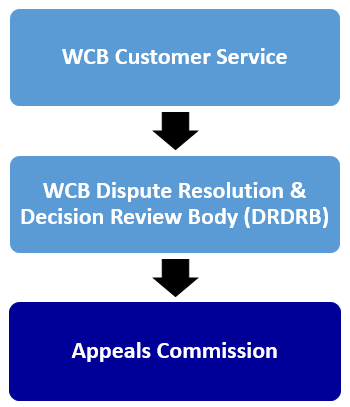If you are not satisfied with a decision made on your WCB claim, your Advisor will help you to appeal the decision. There are three levels in the WCB appeals process.
If you disagree with the WCB customer service decision, you may appeal to the WCB’s DRDRB. If you disagree with the DRDRB decision, you may appeal to the Appeals Commission.

Step 1: WCB Customer Service
This step asks the WCB decision-maker (Adjudicator/Case Manager) to review the decision. Your Advisor will send a memo to WCB Customer Service. By applying WCB policy and the Workers Compensation Act, this document explains the reasons why WCB should change the decision.
Initial contact from WCB Customer Service is usually sent within five business days. If the decision is not changed, it goes to a WCB Supervisor. After reviewing the decision, the Supervisor decides to either keep the same decision or change it. If an investigation is warranted, WCB will send another letter with the decision.
If the decision is not changed, the appeal can be sent to the Dispute Resolution and Decision Review Body (DRDRB).

Step 2: Dispute Resolution and Decision Review Body (DRDRB)
This is the first formal level of review in WCB’s appeal process. The DRDRB is an internal review body within WCB. The DRDRB arranges the hearing in the format you request (in person, by teleconference/video conference or documentary review). All interested parties are invited to participate.
A Resolution Specialist reviews the appeal considering the submissions and the relevant documents. DRDRB sends the written decision typically within 40 calendar days.
If the DRDRB does not change WCB’s decision, the appeal can proceed to the Appeals Commission.

Step 3: The Appeals Commission (AC)
The AC hearing panel has three Commissioners, independent of WCB, and hears appeals of DRDRB decisions.
The AC arranges the hearing in the format you request (in person, by teleconference/video conference or documentary review). All parties to the appeal will be invited to participate. A written decision is normally sent within six to eight weeks. This timeline may be longer or shorter depending on the complexity of the appeal.
This is the final level of appeal for workers and employers who disagree with a DRDRB decision
Early Resolutions
One focus of the Advisor Office is early resolution, which means that an issue no longer needs to be appealed. The general expectation is that all new issues will have an attempt made to resolve them early (where possible). This is done by working with the WCB Customer Service or with clients directly. The early resolution may involve the WCB Customer Service Department changing their decision, and therefore, the issue is considered "resolved".
Timelines for Appeals
There is a one-year time limit to appeal decisions of the WCB Customer Service Department to the DRDRB, and one year to appeal decisions of the DRDRB to the Appeals Commission.
Note: If the DRDRB decision is dated on or after April 1, 2021, you have one year to submit your appeal. If it is dated from September 1, 2018, up to and including March 31, 2021, you have two years to submit your appeal (based on legislation in place at the time of the decision).
The date of the decision letter is important. Time limits should not be missed as the right to appeal an issue may be permanently lost if the time limit has passed.
If clients miss a time limit, applications may be made to extend the time limit. However, there is no guarantee of success in making those applications. Both the DRDRB and the Appeals Commission have processes to waive missed time limits under certain circumstances. Contact your Advisor if you have questions about a missed time limit.
Outcomes of Appeals
Decisions at all three levels can have the following outcomes: